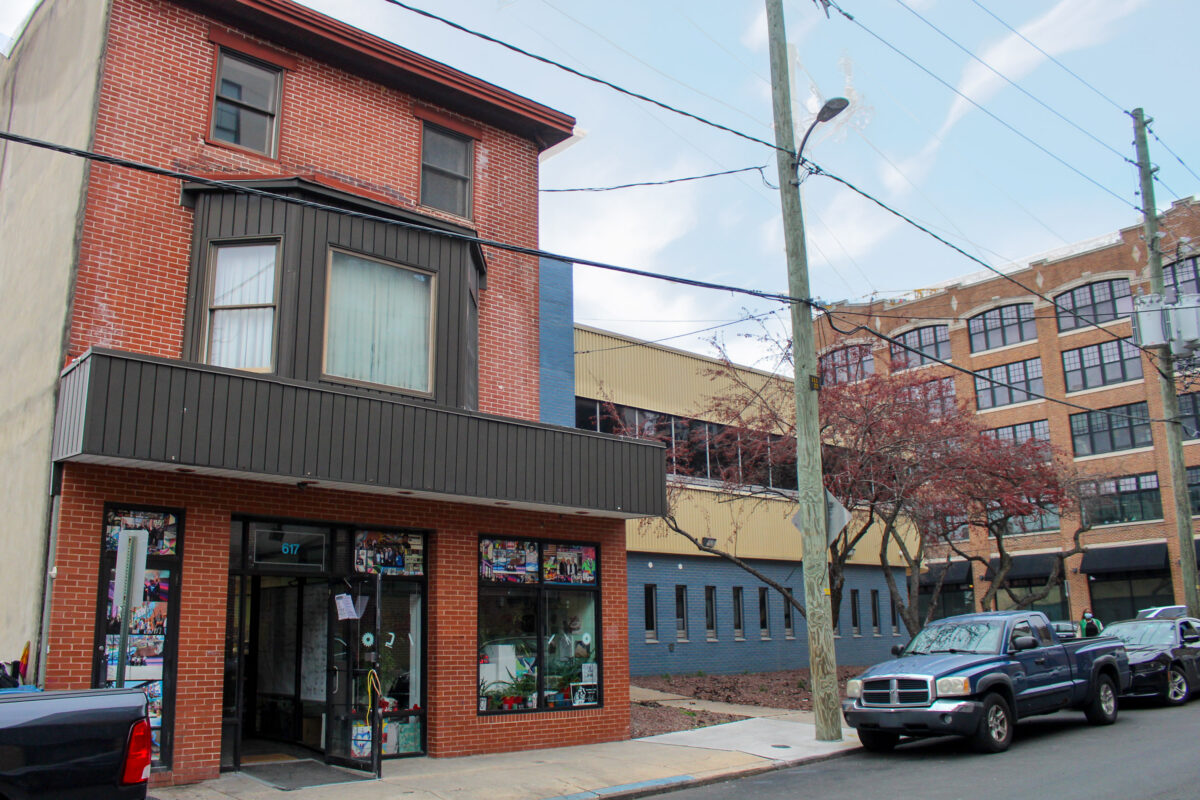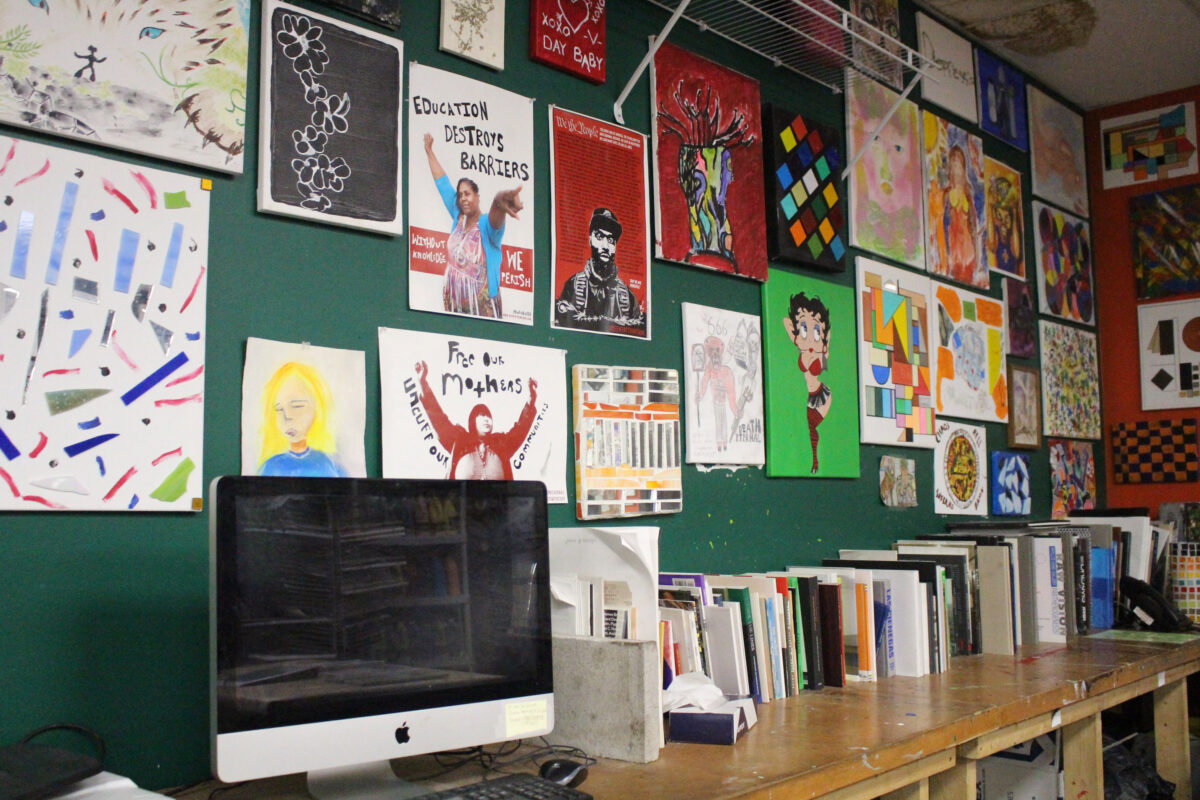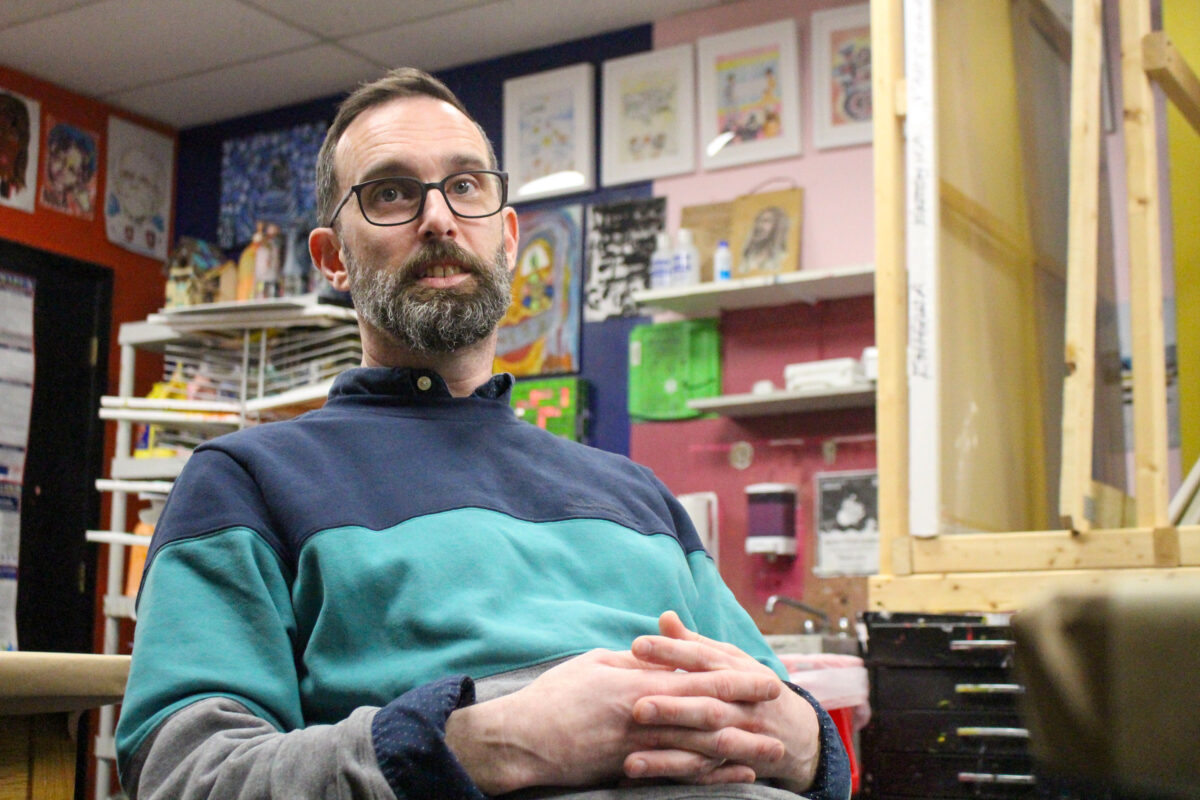Then, the Creative Vision Factory, the art-focused peer-run community mental health program that Kalmbach has nurtured for the past dozen years, will depart downtown Wilmington, quite likely leaving behind the nearly 100ndividuals facing homelessness, dealing with mental health issues and , recovering from addiction – who visit the sanctuary at 617 N. Shipley St. on a typical day.
They have long counted on the center for support, solace, a cup of coffee and a place to charge their cell phones.
On May 3, as part of the monthly Wilmington Art Loop, the Creative Vision Factory will hold its final show as well as “a clearance sale,” giving its artists one last chance to sell their works and to begin disposing of supplies and materials that won’t be needed two months from now.
On July 1, the Creative Vision Factory will begin a partnership with Impact Life, a larger agency that focuses on serving individuals with substance abuse disorders. Creative Vision Factory will share space with Impact Life, either in a building leased from the Elsmere Police Department or at an undetermined Impact Life site in Newark. The question of location won’t be resolved until later this month, at the earliest, pending the outcome of Impact Life’s contract negotiations with the state Division of Substance Abuse and Mental Health.
For Kalmbach and his longtime assistant, Chantal Matthews, the move could be “an opportunity to regroup and get out of the frying pan.” For the Creative Vision Factory’s clients, Kalmbach is less optimistic. Most are unemployed and have limited resources. Many now stay at the Sunday Breakfast Mission, the only homeless shelter in downtown Wilmington. Few are likely, he said, to have the bus fare needed to reach a new site in Elsmere or Newark.
Instead, he believes that most will revert to spending their daylight hours on the streets or taking refuge in public spaces like the Wilmington Public Library. It is also possible that Horizon House, the Philadelphia-based behavioral health agency that has served as Creative Vision Factory’s fiscal agent, will take over programming at the Shipley Street site. If that occurs, Kalmbach says Horizon House will face challenges not only in working with his current clients but, more importantly, gaining acceptance in a neighborhood that has become less welcoming to those recovering from substance use disorder and facing mental health issues. .
The Creative Vision Factory’s stay in Wilmington is a story of polarization — of the uneasy tension and conflict between promoters of urban gentrification and a mini-community of troubled individuals striving to reclaim their dignity and self-respect that is rarely spoken about openly
By the numbers
Operations like Impact Life and the Creative Vision Factory serve some of the most troubled and most needy segments of Delaware’s 1 million residents.
According to NAMI Delaware, an affiliate of the National Association on Mental Illness, 42,000 adult Delawareans have a serious mental illness and 149,000 adults have a mental health condition.
About 79,000 Delawareans ages 12 and older had identified substance use disorders, according to a 2019 report by the US Substance Abuse and Mental Health Services Administration. Last year, the state recorded 527 deaths from accidental drug overdoses.
Housing Alliance Delaware, in its 2023 point-in-time count, found 1,245 homeless individuals, including 198 in unsheltered locations. The state’s homeless rate of 12.1 per 10,000 people is higher than 2023 rates in New Jersey (11), Pennsylvania (9.7) and Maryland (9.5), according to the US Department of Housing and Urban Development.
Many substance abusers are also dealing with mental health issues, according to Domenica Personti, founder and CEO of Impact Life. Most homeless individuals suffer from addiction or a mental health condition, Kalmbach said.

Creative Vision Factory’s beginnings
Established as a peer resource center in 2011 following the state’s settlement of a lawsuit filed by the US Department of Justice over the warehousing of mental health patients at the Delaware Psychiatric Center, the Creative Vision Factory employs an art therapy toolkit to ease the mentally ill and the addicted onto a path toward stability and sobriety.
Its emphasis on public art helped the program gain recognition and respect. Its projects have included a 200-foot-long mural depicting Wilmington’s maritime history on the wall of a former warehouse opposite the Kalmar Nyckel Shipyard; mosaic benches at Winterthur Museum, Garden & Library; mosaic walls inside Stubbs Elementary School in Wilmington and outside the Christina Cultural Arts Center in downtown Wilmington; and a memorial wall at the spiral cemetery at the Delaware Psychiatric Center. Regular shows as part of the Wilmington Art Loop have built awareness of the program and its artists’ work.
Kalmbach’s connections in the art world have brought Creative Vision Factory members recognition beyond Wilmington. Two of its artists, Knicoma Frederick and Geraldo Gonzalez, have had their works exhibited in Philadelphia, New York and even in Melbourne, Australia.
Frederick, a prolific artist who creates hundreds of works per year, told Delaware Public Media in 2022 that he “just showed up” at the Creative Vision Factory soon after it opened in 2011. “It gave me a place to chill out, to relate to people, to talk about art …. Now, I’m around people who are interested in artwork,” he said.
“What Michael [Kalmbach] created was meeting people where they are, to engage them in a recovery-informed setting, to build their confidence,” said Rita Landgraf, state secretary of health and social services when the Creative Vision Factory opened and now director of the University of Delaware’s Partnership for Healthy Communities.
The importance of peer support
The Creative Vision Factory was one of many peer support programs launched throughout the state under Landgraf’s watch as part of the 2011 DOJ settlement.
Peer support is an essential component in the recovery toolkit, for both addiction and mental health, Landgraf said. “Who is better to help someone who is going through a crisis than someone who has had a lived experience?” she asked.
“The settlement was pretty broad. It allowed us to create a robust peer support system,” Landgraf said.
The Creative Vision Factory was unique, as it was the only one centered on art therapy. Also, she said, Kalmbach has a knack for letting peers develop their strengths in serving as mentors without, as often occurs in recovery programs, turning them into case managers, something they’re not equipped to do.
Kalmbach, 43, who has been sober for 22 years, and his staff – currently Matthews and two part-timers – have helped those in need in myriad ways, including finding housing, accessing social services and giving them a place to establish relationships and develop the confidence they need to manage in a society that can be overwhelming and inhospitable.
The Creative Vision Factory’s service numbers grew steadily until the COVID-19 outbreak in early 2020. In 2012, the program had 2,047 visitors. By 2019, that number grew to 14,910. Numbers dropped during the pandemic, but total visits topped 15,000 last year, surpassing the pre-pandemic peak.
Those numbers can be taken in two ways. Kalmbach said the statistics demonstrate the need for more staff. Serving so many people with such a small staff – never more than seven, full- and part-time, before the pandemic – caused Kalmbach and his team to burn out. But state officials took the figures the other way, as evidence that a small team can serve large numbers of people in need.
Landgraf understands Kalmbach’s position. In spending five years nurturing the peer centers during the administration of former Gov. Jack Markell, “we believed that our work was the floor, not the ceiling. We tried to create a system of care so we could not go backward again.”
Systems are meant to evolve as populations change and evolve, Landgraf said, and she hoped that the administration of Gov. John Carney would continue the forward movement. Instead, she said, Carney’s team “saw the [Department of Justice settlement] as a one-and-done. It was not a priority for them.”
Personti, at Impact Life, said the current leadership of the state Division of Substance Abuse and Mental Health is supportive of the peer centers but she doesn’t believe the agency has sufficient resources to enable the centers to operate at optimal levels.

Wearing out its welcome?
When the COVID-19 pandemic struck in March 2020 and New Castle County set up the Hope Center in a former hotel outside of Wilmington to help house the homeless, it turned to Kalmbach and Creative Vision Factory to arrange focus groups and determine best practices. “When I look back, it was the most important thing we did. It was very impactful,” Carrie Casey, the county’s general manager of community services, said in 2022.
By then, however, the Creative Vision Factory had already begun to wear out its welcome on Shipley Street, one block west of Market Street, the spine of Wilmington’s ongoing regentrification efforts.
The uncertainty had been building for years, dating to the program’s early days, before the recent spurt of construction of luxury high-rise residences downtown. The city and the Buccini/Pollin Group, a major developer both on the Christina Riverfront and downtown, were promoting an upscale “live, work and play” vibe designed to attract 20- and 30-somethings into renovated second- and third-floor apartments above the shops on Market Street.
Artist Nancy Josephson, a Market Street resident who spent several years volunteering at the Creative Vision Factory, recalls a conversation she had on Market Street with a member of the Wilmington City Council. “I asked her, ‘What does inclusive regentrification look like?’ She looked back and answered, ‘I don’t know.’”
In any community, Josephson said, it’s important for neighbors to connect with each other, but it’s not always easy in a changing environment with a mix of upwardly mobile young professionals and individuals struggling with housing, addiction and mental health issues. There can be a disconnect, she said, between people “paying $1,400 a month in rent” and those who appear to be “camping out on the sidewalk.”
Josephson tells the story of a Creative Vision Factory patron named Brian. “He was huge, largely nonverbal. He had instability,” she said. And he had this habit of taking his clothes off in the middle of the block. Brian’s stature and behavior could easily intimidate neighboring residents, Josephson said, but, because she had established a relationship with him in the program, “I could get him to stop, I could get him to calm down.”
Over time, however, the downtown environment had become less hospitable for the Creative Vision Factory’s staff and clients. As developers continue to construct luxury high-rise apartments in the area, the drop-in center on Shipley Street for those facing homelessness and coping with addiction and mental health issues has increasingly seemed out of place.
“We now have people not just looking down on us, they were literally looking down on us,” Kalmbach said.
Indeed, the Creative Vision Factory stands adjacent to a seldom filled surface parking lot that would appear to be a prime target for residential redevelopment.
Earlier this year, with Creative Vision Factory’s contract with the state due to end on June 30 and future funding prospects unclear, Kalmbach began searching for other options. Josephson arranged a meeting in her kitchen for Kalmbach with Rob Buccini, co-president of the Buccini/Pollin Group, to explore whether any of the developer’s properties might serve as a new site. “Rob was engaged and friendly,” Kalmbach said, but all the meeting produced was an introduction to a commercial real estate broker who showed him a vacant storefront on Market Street that wouldn’t meet the program’s needs.
Buccini “did what he could to make options available, but they weren’t going to line up, for all kinds of reasons,” Josephson said.
In any event, Kalmbach notes, uncertainty over state funding beyond July 1 would have made it difficult for the Creative Vision Factory to sign a lease for another location.
While it may be easy to blame developers for pushing social service agencies out of the way of their multimillion-dollar projects, Josephson said that’s not the case here. “It’s complicated, but this is what living in a changing environment is,” she said. “You have to meet people where they are,” but that’s not easy when there’s such a cultural gap between the upwardly mobile and individuals worried about where they’ll sleep at night.”
As a social services administrator and observer, Landgraf has observed many such situations in her career. Whenever there’s discussion about a site for a new program, she said she often hears, “Don’t locate it in the city. Move it out. We have a disproportionate share.”
Connecting with Impact Life
As Kalmbach sought a new path forward, he reconnected with Personti, the founder and CEO of Impact Life, someone he had known through their shared work in the recovery community.
They reached an agreement – final terms still to be worked out – that will make Creative Vision Factory one of the numerous recovery programs under the Impact Life umbrella.
“My goal is to grow [Impact Life] and to have Creative Vision Factory be what it was. It may look smaller at first, housed within one of our other programs, then go back to what it was,” Personti said.
“Impact Life is a cultural fit, our best hope for the future. There is now the potential for us to regroup,” Kalmbach said.
Impact Life, which provided a variety of peer-led addiction recovery services to nearly 12,000 individuals in Delaware in 2023, plus more in two counties in Maryland, opened a resource center in Elsmere earlier this year. Personti believes a partnership with the Creative Vision Factory will enhance both programs.
“I’ve known Michael for years. It could be a beautiful marriage. He does a lot of things we don’t do. He led the oldest peer resource center in the state,” Personti said.
Personti is especially interested in attempting to integrate Creative Vision Factory’s art therapy work into Impact Life’s programming. “Our art program is in its infancy. We also do culinary arts. We want to grow these programs in a meaningful way,” she said.
Impact Life, with a staff of 50 and operations throughout the state, has a broad reach. Its programs include a 17-acre farm near Seaford where residents learn agricultural skills; a culinary arts program that can lead to employment in food service; wellness programs for women and their babies, along with 14 “recovery residences” that provide temporary housing for about 120 in recovery.

The next steps
Creative Vision Factory can help Impact Life expand its art therapy efforts, and Personti said she and Kalmbach are talking about expanding its reach to include at-risk youth, a move that could create a pathway to new funding opportunities.
Unresolved, at least for now, is whether Creative Vision Factory’s programming will land in Elsmere or in Newark. “We just want to serve people where the need is,” Personti said.
Either location would not be convenient for the program’s current clients, Kalmbach said, but those in Wilmington will have a slightly easier time getting to Elsmere by bus than to Newark.
If they can’t get to Elsmere or Newark, it’s not clear where Creative Vision Factory’s current clients will spend their days. “They’ll go someplace else. It’s not like they’ll be waiting for it to appear again,” Josephson said. “But this has been home for the members, the staff … their safe space too. It’s one less place to give solace and sustenance.”
Should Creative Vision Factory land in Newark, Kalmbach and Personti say it would likely serve a significantly different demographic – closer to college age, more affluent, less likely to be homeless.
Some Newark-based programs do a good job serving those with mental health needs, “but there’s not a lot for people in recovery,” Personti said.
Impact Life does not currently have a presence in Newark, she said, but it would be looking to purchase or rent space in the downtown area, close to the University of Delaware campus. “The program will bloom wherever it is planted,” Kalmbach said. “With Impact Life we will have multiple options, more mobility, we can co-create together with them.”
For two more months, Kalmbach will continue counting the days.
“Things are always coming together or falling apart,” he said. “Right now, we’re in the middle of that process.”







